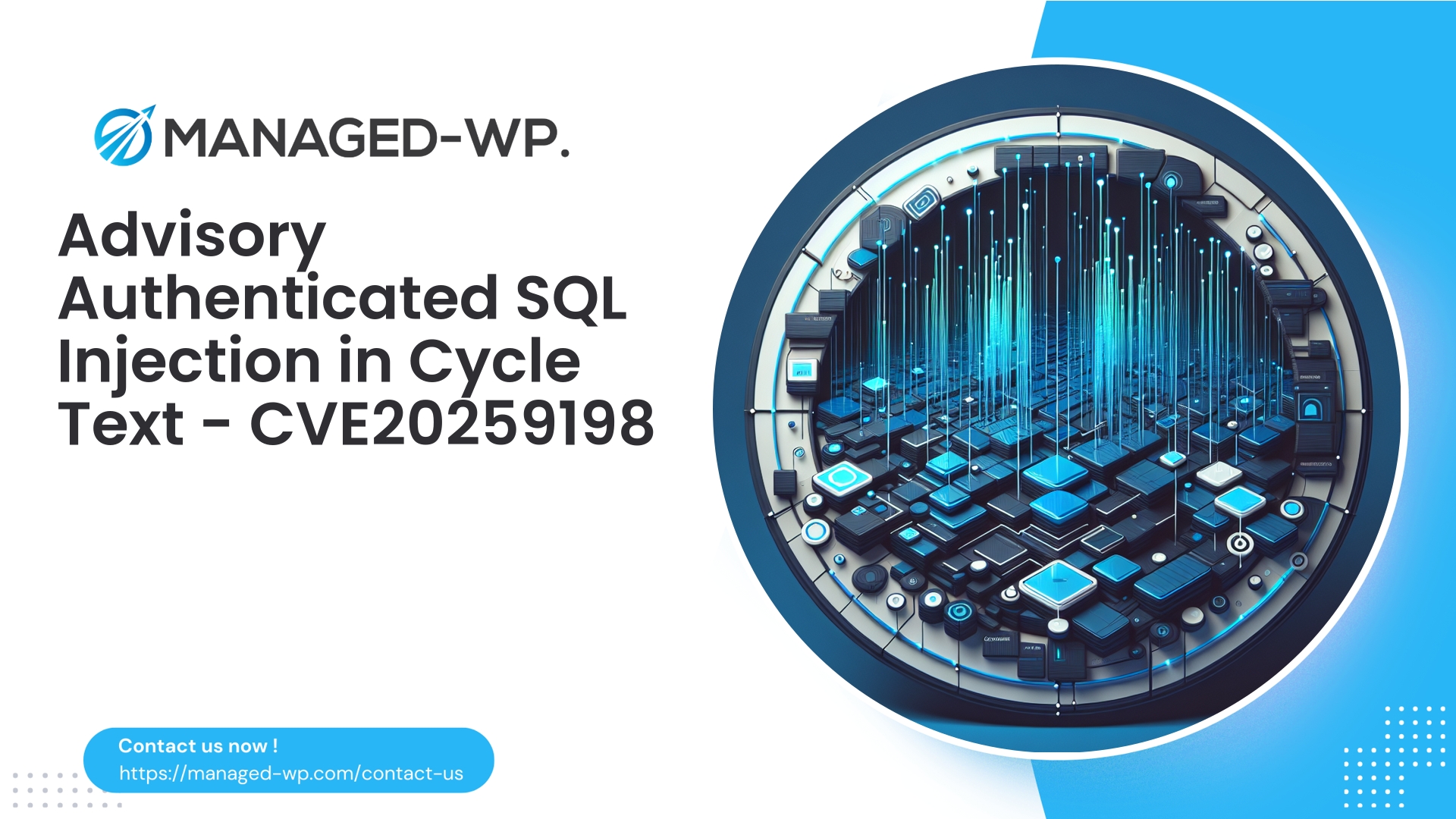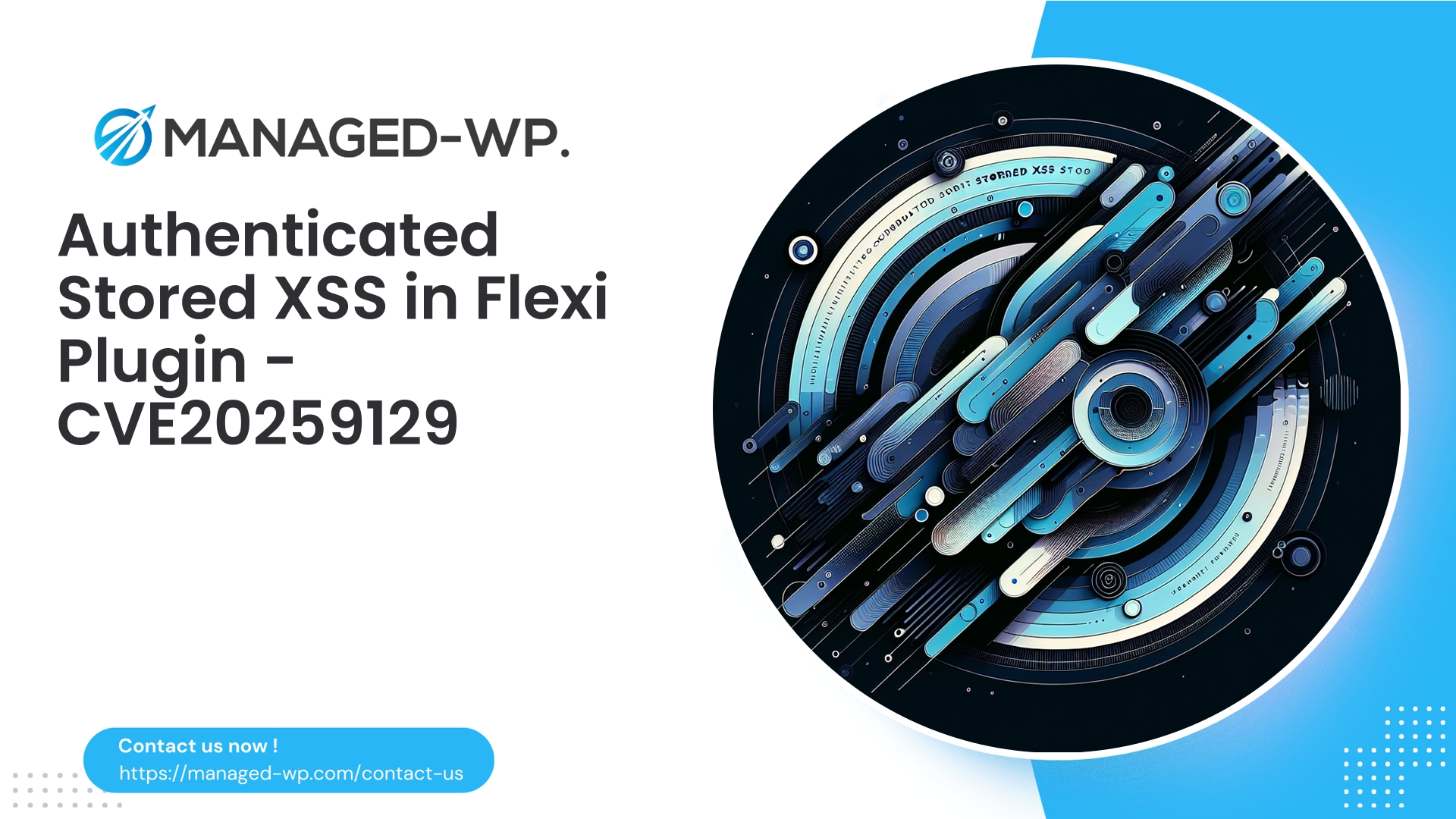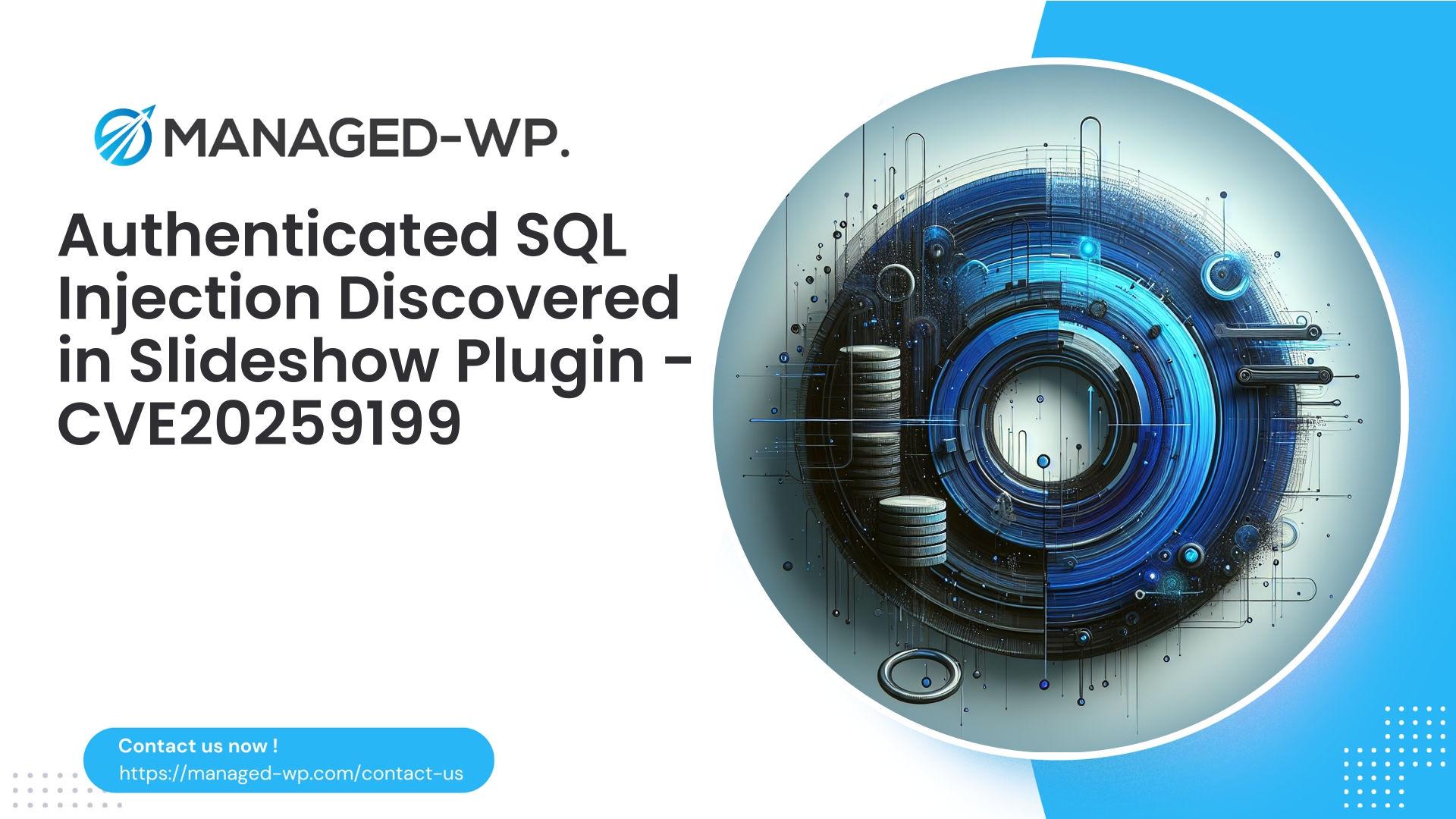| 插件名称 | Wp循环文本公告 |
|---|---|
| 漏洞类型 | SQL 注入 |
| CVE编号 | CVE-2025-9198 |
| 紧急 | 低的 |
| CVE 发布日期 | 2025-10-03 |
| 源网址 | CVE-2025-9198 |
“WP Cycle Text Announcement”(版本 <= 8.1)中的已认证(贡献者及以上)SQL注入漏洞——网站所有者和开发者的必备措施
执行摘要: 编号为 CVE-2025-9198 的安全漏洞使 WordPress “WP Cycle Text Announcement” 插件(版本 8.1 及更早版本)面临 SQL 注入攻击的风险,攻击者可利用此漏洞进行已认证的“贡献者”级别或更高级别的用户进行攻击。虽然利用此漏洞需要已认证的“贡献者”帐户,但其后果可能非常严重,包括未经授权的数据泄露、数据库修改,甚至可能导致整个网站被攻破。目前,官方尚未发布补丁。本文由美国领先的 WordPress 安全服务提供商 Managed-WP 撰写,详细介绍了此漏洞的性质、实际风险、检测策略、即时缓解措施、长期开发者指南,以及 Managed-WP 的虚拟补丁服务如何帮助您立即保护网站安全。
为什么这种漏洞需要您关注
WordPress 网站通常会授予客座作者、合同工或初级编辑“投稿人”角色。以往,投稿人的权限受到限制——他们不能发布内容或上传文件。但是,他们可以提交数据,如果插件未能充分清理这些数据,则可能导致 SQL 注入攻击。
WP Cycle Text Announcement 插件接受投稿者提交的内容,并将其不安全地嵌入到 SQL 查询中。拥有投稿者帐户的攻击者可以操纵这些查询,从而窃取数据、提升权限或建立持久性后门。这一风险凸显了非管理员角色所面临的漏洞的真正危险性——这对于 WordPress 网站安全治理至关重要。
细节:
- CVE ID: CVE-2025-9198
- 受影响的插件: WP Cycle 文本公告(版本 ≤ 8.1)
- 所需权限: 已认证 – 贡献者或更高级别
- 补丁状态: 截至发稿时,尚未有官方修复方案。
- 披露日期: 2025-10-03
技术概要(非剥削性)
当用户输入未经适当转义或参数化就被集成到数据库查询中时,就会出现 SQL 注入漏洞。WordPress 插件经常通过这种方式与数据库交互。 $wpdb 类。安全编码标准规定了使用 $wpdb->prepare() 防止注入攻击。
在 WP Cycle Text Announcement 中,SQL 查询直接集成贡献者提交的值,而没有参数化,这使得恶意输入可以修改预期的查询结构。
- 贡献者通过插件界面或 API 提交输入。
- 插件构建包含此输入的 SQL 查询时,未进行充分的清理或
$wpdb->prepare(). - 恶意输入会注入 SQL 片段,从而改变查询的执行方式。
- 数据库会处理篡改后的查询,这可能会泄露机密数据或导致未经授权的修改。
由于利用此漏洞需要经过身份验证的贡献者帐户,因此它被归类为“经过身份验证的 SQL 注入”。漏洞利用需要一定程度的用户访问权限,但考虑到在许多网站上创建贡献者帐户的便捷性,不应低估其风险。
潜在攻击场景
- 数据盗窃: 提取用户详细信息、未发布的草稿或存储的配置值(包括 API 密钥)。
- 权限提升: 通过篡改相关数据库表来修改用户角色或添加管理员帐户。
- 后门: 将恶意内容注入插件/主题设置中,从而启用远程代码执行。
- 侧向攻击: 利用共享凭证影响共享同一数据库或环境的其他站点。
- 运营中断: 通过资源耗尽导致数据库错误、数据损坏或拒绝服务。
笔记: 影响程度取决于数据库用户权限和查询上下文。
为什么贡献者级别的漏洞是一个严重问题
网站管理员常常低估投稿人账户的价值,因为他们的发布权限有限。然而:
- 贡献者仍然会提交可能用于特权查询的数据。
- 开放注册或宽松的审核机制可能导致攻击者控制贡献者账户。
- 自动注册和社交工程技术使得批量创建账户成为可能。
- 内部团队可能拥有贡献者帐户,这些帐户可能被盗用或胁迫。
此漏洞凸显了保护所有已认证角色(而不仅仅是管理员)的重要性。
立即检测步骤
如果您的网站使用 WP Cycle Text Announcement(≤8.1 版本)或拥有投稿人帐户,请立即采取行动:
- 确认插件安装及版本: 访问 WP 管理后台 > 插件,验证该插件是否已安装且存在漏洞。
- 查看日志是否存在可疑活动:
- Web 服务器访问日志,记录异常 POST 操作。
- PHP错误日志显示SQL错误。
- 数据库日志中是否存在具有可疑模式的异常查询。
- WordPress 审核日志(如果已启用)用于记录贡献者在插件数据方面的操作。
- 识别剥削迹象:
- 意外创建管理员帐户或角色变更。
- wp_options 或 wp_posts 中存在可疑修改。
- 与插件活动相关的数据库负载过高或不稳定。
- WordPress 的出站连接尝试异常。
- 文件系统验证:
- 扫描插件/主题目录,查找新修改的文件。
- 检查 uploads 和 mu-plugins 文件夹中是否存在未知的 PHP 文件。
如果发现可疑活动,请将该网站视为已被入侵,并按照下文详述的事件响应协议进行操作。
紧急缓解措施清单
- 立即停用插件 如果可能的话:
WP 管理后台 > 插件 > 停用“WP Cycle Text Announcement”。 - 如果立即停用不可行:
- 未经明确信任,移除或限制贡献者帐户。
- 暂时降低贡献者及以上用户角色的权限。
- 强制执行强身份验证措施:密码重置、会话审查、为编辑/管理员启用双因素身份验证。
- 限制对插件端点的访问:
在可行的情况下,通过 IP 地址阻止或限制对插件管理界面的 HTTP 访问。 - 应用虚拟补丁/WAF保护:
部署 Managed-WP 的虚拟补丁或类似的 WAF 规则,以阻止应用程序层的漏洞利用尝试,而无需修改插件代码。 - 备份:
在进行任何更改之前,请对网站文件和数据库进行完整的离线备份,以保留取证数据。 - 密切监控日志:
采取缓解措施后,至少观察两周的活动,以确保不再发生类似尝试。
安全开发建议
维护受影响插件或类似代码库的开发人员应采取以下步骤进行修复并确保其未来兼容性:
- 实现参数化查询:
使用$wpdb->prepare()而不是简单的字符串拼接。 - 对所有输入进行清理和验证:
应用适当的消毒功能(sanitize_text_field(),intval(),esc_url_raw())并验证预期值范围。 - 强制执行能力检查:
使用诸如以下功能验证用户权限当前用户可以()而不是仅仅依靠角色。 - 使用 nonce 来保护表单和 AJAX 端点:
实现 WordPress nonce API(wp_create_nonce(),检查管理员引用者(), 和检查 Ajax 引用者()). - 优先使用 WordPress API 调用,而不是原始 SQL:
尽可能使用 WP_Query 及相关抽象层。 - 限制数据库权限:
限制数据库用户权限,仅允许执行必要的操作。 - 正确的错误处理:
禁止公开发送详细错误信息;改为安全地记录错误日志。
如果插件开发者在补丁创建或虚拟补丁实施方面需要支持,Managed-WP 可提供专家协助。
Managed-WP 的虚拟补丁如何保护您的网站
Managed-WP 部署有针对性的 Web 应用程序防火墙 (WAF) 规则,这些规则充当虚拟补丁。这些规则在网络边缘拦截恶意请求,从而在官方补丁发布之前缓解漏洞利用的风险。
- 阻止针对易受攻击的插件端点的已知 SQL 注入模式。
- 检查并过滤用户输入中的可疑 SQL 令牌。
- 限制贡献者级别用户的请求速率,以减少自动化攻击。
- 尽可能将终端访问权限限制在受信任的用户角色或 IP 地址范围内。
- 提供详细的日志记录和警报,以便管理员能够实时响应被阻止的漏洞利用。
启用托管 WP 虚拟补丁可确保在漏洞披露窗口期间持续提供保护。
建议的WAF规则(概念框架)
- 规则 1:阻止贡献者用户发送包含 SQL 元字符与 SQL 关键字(例如 UNION、SELECT)组合的插件端点请求。
- 规则 2:拒绝包含注入序列的输入(
--,/* */,或 1=1) 其中仅期望输入简单的文本或数字。 - 规则 3:限制贡献者帐户向插件端点发出的 POST 请求,以对抗暴力破解或自动注入尝试。
- 规则 4:在服务器端强制执行数据库查询参数的数字和枚举验证。
我们建议在部署前在测试环境中测试 WAF 规则,以避免干扰正常流量。
事件响应:分步指南
- 包含: 停用存在漏洞的插件。如有必要,请考虑将网站设置为维护模式。
- 保存证据: 更改之前,请创建完整备份和安全日志。
- 调查: 审核用户帐户,数据库表更改(
wp_options,wp_users,wp_posts),并审查日志以发现可疑活动。 - 补救措施: 如果备份遭到破坏,则恢复干净的备份,轮换密钥(API 密钥、盐值),并重置特权用户的凭据。
- 恢复: 一旦有补丁插件版本可用,立即部署或维持虚拟补丁;应用安全加固措施。
- 事件发生后: 记录调查结果,通知利益相关者,并遵守任何监管报告要求。
如需协助进行事件管理,Managed-WP 安全专家可指导遏制和恢复工作。
长期强化措施
- 及时更新 WordPress 核心程序、主题和插件。
- 减少插件和主题臃肿程度;移除未使用或已弃用的软件。
- 遵循最小权限原则:谨慎分配角色,避免不必要的贡献者账户。
- 强制使用强密码,并为特权用户启用双因素身份验证。
- 使用基于主机或基于插件的文件完整性监控和恶意软件扫描。
- 确保数据库凭据安全,并尽可能限制权限。
- 使用现代 TLS 配置通过 HTTPS 提供流量。
- 定期进行备份并测试恢复流程。
- 启用全面的安全日志记录并主动监控异常情况。
- 部署具有虚拟修补功能的信誉良好的WAF,以缓解零日漏洞。
- 在部署之前,根据更新频率和安全记录对第三方插件进行严格审查。
安全编码最佳实践
以下是一些从不安全的数据库交互过渡到安全数据库交互的示例方法:
- 将原始 SQL 与用户输入进行转换: 从字符串连接到预编译语句。
- 验证 AJAX 端点和表单: 使用
检查 Ajax 引用者()并确保进行能力检查当前用户可以(). - 利用 WordPress API: 除非绝对必要,否则请优先使用 WP_Query、get_post() 和 update_post_meta() 函数,而不是原始 SQL 语句。
如有疑问,请进行彻底的安全代码审查,重点关注所有方面。 $wpdb 用法和直接 SQL 字符串。
团队和机构沟通指南
- 向客户和内部团队通报风险、已采取的措施和后续步骤。
- 对于代理机构,应审核所有客户网站,检查是否存在易受攻击的插件使用情况和贡献者角色暴露情况。
- 建议酌情重置贡献者的凭证并进行访问权限审查。
透明的沟通能够促进各利益相关方之间的信任和协调一致的补救措施。
补丁调度优先级建议
- 运行存在漏洞版本且有贡献用户的网站应优先进行漏洞评估和缓解。
- 如果不存在贡献者级别的账户或对其控制非常严格,风险就会降低,但缓解措施不应拖延。
- 未使用该插件的网站无需立即采取任何行动,但应定期进行插件组合审查。
风险评估必须考虑用户角色、网站暴露情况、托管环境和托管数据的敏感性。
隆重推出 Managed-WP 免费防火墙计划
提升 WordPress 安全性 — 免费托管防火墙保护
在等待官方插件更新期间,Managed-WP 提供免费的基础套餐,可立即增强您的安全防护。该套餐包含托管防火墙保护、应用层 WAF、定期恶意软件扫描以及 OWASP Top 10 风险缓解措施。
基础套餐提供无限带宽,并涵盖关键攻击途径,让网站所有者无需复杂设置即可立即安心无忧。高级套餐在此基础上增加了自动恶意软件清除、IP地址允许/阻止管理、每月安全报告以及针对CVE-2025-9198等漏洞的自动虚拟补丁功能。
了解更多信息并在此注册: https://my.wp-firewall.com/buy/wp-firewall-free-plan/
计划概要: 基本版(免费)—托管防火墙、WAF、恶意软件扫描、OWASP Top 10 缓解措施。
标准版——自动清除恶意软件 + IP 允许/阻止控制。
专业版——每月安全报告、自动虚拟补丁和高级功能。
接下来的72小时行动计划
- 清点所有运行 WP Cycle Text Announcement ≤ 8.1 的网站。
- 通过停用插件或限制插件端点访问权限来控制风险。
- 启用托管式 WP 虚拟补丁或等效的 WAF 保护。
- 审核贡献者账户并执行严格的身份验证策略。
- 进行完整的离线备份,以保持取证完整性。
- 计划在有永久性代码修复或官方补丁可用时应用这些修复程序。
- 密切监控网站活动和日志,以发现安全漏洞。
结论
诸如 CVE-2025-9198 之类的已认证 SQL 注入漏洞表明,即使权限较低的用户,在插件安全措施不足的情况下,也能对 WordPress 网站造成严重的安全威胁。有效的防御措施需要多层次的应对:立即采取缓解措施(例如停用插件、限制访问权限),通过 Managed-WP 等 WAF 技术进行虚拟修补,以及精心实施的安全开发实践,重点关注参数化查询和严格的输入验证。
如需漏洞评估、虚拟补丁实施或代码审计方面的全面协助,Managed-WP 的专家团队随时准备为您的 WordPress 安全防护提供支持。立即激活我们的免费基础套餐,在修复期间保护您的网站: https://my.wp-firewall.com/buy/wp-firewall-free-plan/
参考文献及延伸阅读
- 官方 CVE-2025-9198 条目
- WordPress插件库 – 验证已安装插件版本
- WordPress开发者资源 –
$wpdb->prepare()以及数据清理最佳实践 - OWASP注入攻击概述
向 Managed-WP 索取定制的修复清单和虚拟补丁规则示例,以加快您的事件响应速度并有效保护您的 WordPress 环境。



















